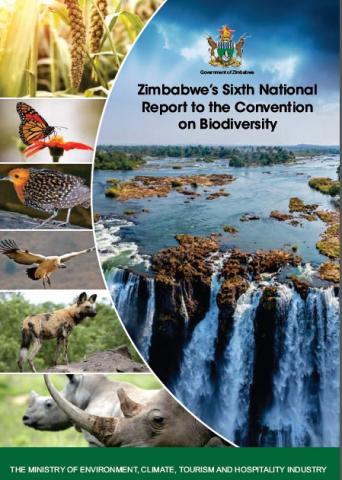Zimbabwe's Sixth National Report to the Convention on Biological Diversity
What is the National Biodiversity Sixth National Report (6NR)?
Zimbabwe is a party to the United Nations Convention on Biological Diversity (CBD) and accordingly has obligations to implement the provisions of the convention. Article 26 of the convention requires Zimbabwe to produce a national report every four years. Zimbabwe’s 6NR to the CBD and it presents measures that the country has taken to implement the National Biodiversity Strategy and Action Plan (NBSAP), their effectiveness, as well as their support and contribution, to the implementation of the 2030 Agenda for Sustainable Development and the Sustainable Development Goals. The reporting system assists the country in considering lessons learnt, identifying gaps in capacity for policy research and analysis at the national level, including technical and financial requirements, and formulating appropriate actions for the future.
Summary of measures, effectiveness and needs
T*- Target
|
T* |
Implementation measures |
Effectiveness |
Scientific and technical needs |
|
1 |
Biodiversity education and awareness |
Effective |
Training in data collection, storage and management |
|
2 |
Use ecosystem services valuation tools to mainstream biodiversity all seven sectors |
Partly effective |
Training in biodiversity and ecosystem services valuation, environmental reporting and accounting |
|
3 |
Strengthen institutional capacity, promote sustainable land management practices and development of renewable energy |
Partly effective |
Develop a framework for monitoring and evaluating the implementation Training personnel in data collection and analysis
|
|
4 |
Promote the application of ecosystem-based approaches to aquatic resources management on Lake Kariba and other water bodies |
Partly effective |
Investment in human capital, speed up the development of fisheries policy |
|
5 |
Ssafeguard the conservation of biodiversity and promote sustainable utilization of land. |
Partly effective |
Investment in human capital and resources for monitoring and data collection |
|
6 |
Prevent pollution of ecosystems |
Partly effective |
invest in upgrading of laboratory equipment of institutions such as EMA, ZINWA and universities Training in monitoring and control of pollution as well as the evaluation of impacts on ecosystem function and biodiversity |
|
7 |
development and implementation of management plans for control of priority IAS. |
Partly effective |
Training of taxonomists in all major fields of taxonomy, Training in the use of tools for rapid assessment of the distribution and abundance of IAS, Development of an information hub for non-native species in Zimbabwe that covers identification tools and information on impacts, control and eradication measures |
|
8 |
Incorporation of biodiversity conservation action in the national disaster risk reduction strategy |
Partly effective |
environmental policies must prioritize poverty reduction. Enhanced support for poverty reduction programmes across the country |
|
9 |
Coordination and integration of the implementation of conventions, Adaptive ecosystems management approach, |
Partly effective |
Training in the assessment of management effectiveness for PAs |
|
10 |
Conservation and protection of threatened species |
Partly effective |
Adequate funding for regular assessment of population trends and status of threatened species. |
|
11 |
Ex situ and in situ Conservation Private, public and community participation Safeguarding genetic diversity |
Effective |
Training in developing, establishing and maintaining a database for cultivated, farmed and domesticated genetic resources and their wild relatives Training in the use of big data tools and techniques |
|
12 |
Improve conservation and management status of ecosystems; Ecosystems approach to livelihood enhancement Policy formulation and Implementation Gender mainstreaming |
Effective |
Support and implementation of programmes targeting women’s empowerment and poverty alleviation, especially in the rural areas |
|
13 |
Enhance ecosystem resilience |
Partly effective |
Capacitation of local authorities in waste management and environmental restoration |
|
14 |
Accession to and domestication of the Nagoya Protocol |
Partly effective |
Capacity building in developing domestic ABS legislation to implement the Nagoya Protocol. |
|
15 |
NBSAP adoption as policy and planning instrument |
Partly effective |
Provision of adequate funding to assess annually the implementation of NBSAP and produce annual reports. |
|
16 |
Community empowerment and Participation Mainstreaming indigenous knowledge systems (IKS) into biodiversity conservation |
Partly effective |
Provision of adequate funding to assess annually the implementation of NBSAP2 and produce annual reports. |
|
17 |
Science and technology innovations for reducing biodiversity loss |
Partly effective |
Investment in infrastructure and equipment required for conducting environmental and biodiversity research, Funding for research, Training of taxonomists to cover the broad spectrum of biological organisms |
|
18 |
Making a business case for biodiversity Sustainable financing |
Partly effective |
Training in writing of proposals for accessing funding from international funding agencies. |
Assessment of progress towards each national target
|
National Targets |
Progress towards implementation |
|
1,5,8,9,11,14,15 |
On track to achieve target |
|
2,3,4,6,7,10,12,13,16,17,18 |
Progress but at an insufficient rate |
Zimbabwe’s contribution to the achievement of the Aichi Biodiversity Targets and the Sustainable Development Goals
|
National Target |
Aichi Biodiversity Target |
Sustainable Development Goals Supported Goals Targets |
|
|
Goals |
Targets |
||
|
1 |
1 |
4, 12 |
4.7, 12.8 |
|
2 |
2 |
8, 9, 15, 17 |
8.4, 8.9, 9.1, 9.2, 9.4, 15.9, 17.14 |
|
3 |
5 |
7, 12, 13, 15 |
7.1, 7.2, 12.2, 13.1, 15.1, 15.2, 15.3, 15.4, 15.5, 15.9 |
|
4 |
6 |
1, 2, 15 |
1.4, 1.5, 2.1, 2.2, 15.1, 15.5, 15.9 |
|
5 |
7 |
2, 12, 15 |
2.1, 2.4, 2.5 12.2, 15.1, 15.2, 15.5 |
|
6 |
8 |
3, 6, 11, 12 |
3.9, 6.3, 6.5, 6.6, 11.6, 12.2, 12.4, 12.5 |
|
7 |
9 |
15 |
15.8 |
|
8 |
10 |
1, 2, 5, 11, 13, 15 |
1.1, 1.3, 1.5, 2,1, 2.4, 2.5, 5.1, 5.5, 11.4 13.1, 13.2 13.3 15.1 |
|
9 |
11 |
11, 12, 15 |
11.3, 11.4, 12.2, 15.1, 15.5, 15.7 |
|
10 |
12 |
14, 15 |
14.4, 15.5 |
|
11 |
13 |
2 |
2.1, 2.2, 2.4, 2.5 |
|
12 |
14 |
1, 3, 5, 13 |
1.1, 1.3, 1.5, 3.9, 5.1, 5.5, 13.1, 13.2, 13.3 |
|
13 |
15 |
13, 15 |
13.1, 13.2, 13.3, 15.1, 15.2, 15.3, 15.4 |
|
14 |
16 |
15 |
15.6 |
|
15 |
17 |
5, 16, 17 |
5.1, 5.5, 16.6, 16.7 17.14 |
|
16 |
18 |
2, 5, 10, 16 |
2.5, 5.5, 10.2, 16.10 |
|
17 |
19 |
4, 9, 12, 17 |
4.7, 9.4, 9.5, 12.2, 12.8, 17.6, 17.9 |
|
18 |
20 |
17 |
17.1, 17.6, 17.17 |

